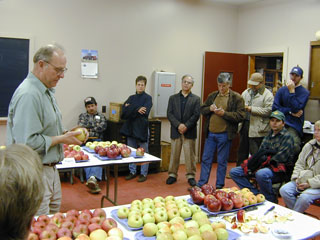 |
Apple Variety Showcase -- November 15, 2001Jon Clements, Extension Tree Fruit Specialist, University of MassachusettsDr. Duane Greene, Professor, Department of Plant & Soil Sciences, University of Massachusetts |
|
On November 15, 2001, an Apple Variety Showcase was held at the UMass Cold Spring Orchard Research and Education Center (CSOREC). Featured were apples grown at CSOREC, mostly from research blocks planted in 1995 and 1999 as part of the NE-183: Multi-disciplinary Evaluation of New Apple Cultivars Regional Research Project. NE-183 is multi-state, multi-disciplinary, and with these objectives:
|
At UMass CSOREC, there are NE-183 'Horticulture' plantings established in 1995 and 1999, and a 'Disease' orchard planted in 1999. Dr. Duane Greene is the UMass Project Leader, and is responsible for horticultural and fruit quality (including sensory) evaluation of tested apples. Dr. Daniel Cooley, Plant Pathology Professor and Agroecology Program Director, studies disease susceptibility of these new varieties in the 'Disease' planting. Jon Clements, Wesley Autio, James Krupa, Arthur Tuttle, and Sara Weis are Project cooperators.
Horticultural data (including tree growth, and fruit yield, quality, and storability) have been collected from the 1995 planting for six years while data collection from the '99 planting (horticulture and disease) has just begun. Therefore, cultivars included in the 1995 planting are well-studied by now, and enough known about them to make recommendations (yes or no) for planting in New England. Although some of these new apples have little (if any) market share now, their outstanding quality -- when combined with adequate promotion -- is likely to make them profitable picks. Of course growers must carefull weigh their market strategy (wholesale, retail, PYO, etc.) before planting any new variety, and are recommended to plant trial orchards first (one acre or less) to see if a new variety will work for them.
Approximately 20 fruit growers -- mostly from Massachusetts, but one from as far away as Quebec, CANADA -- attended the showcase. Dr. Greene (pictured above) briefly discussed the merits and faults of each apple variety on display. For those unable to attend, this photo gallery of NE-183 apple varieties displayed at the showcase includes a brief statement summarizing their worthiness for trial planting in New England. If you have further questions, or need more details, please visit the NE-183 web site or call or e-mail us.
(Note: several apples included in both NE-183 plantings are not included in the photo gallery. One of those with high potential includes Zestar!™, a late-August apple from Minnesota that should appeal to small-scale growers and retail farmstands. It is a fall-like apple with good flavor and crunch, however, it's appearance (poor red color) is a weak spot. Zestar is recommended for growers who have a strong early-season retail market. For more information about Zestar, see the recent Fruit Notes article.)

